How We Made $200 Vinyl DIY RV Skirting for Winter
This post may contain affiliate links.
If you are living in an RV in a cold climate, RV skirting is a MUST. Here is how we did our $200 DIY RV skirting.
RV Skirting Options
There are many options for skirting your RV. After researching the options available for our 5th wheel skirting, we found they pretty much boiled down to these:
- Custom RV skirting. ($$$$) Some companies will come to you, and some require you to travel to them. Either way, this option is great quality, but it’s also the most expensive option. It usually requires drilling holes along the bottom of your RV to install the snaps or channels for hanging the skirting.
- An inflatable AirSkirt. ($$$) An AirSkirt is an inflatable skirting made from heavy-duty vinyl that is inflated by an electric pump and is held in place by pressure. It doesn’t require drilling holes or using any adhesives. It’s designed to be easy to take down, transport, and put back up, so is a great option for people who need to move frequently instead of staying in one place all winter.
- EZ Snap RV skirting. ($$) This self-installed skirting kit is popular with many RVers, but reading about it left me wondering if I could make the same thing for less.
- DIY RV skirting. ($) This can be made from various materials including:
- Plywood or particle board. Sturdy and warm, but not cheap to pay for all that lumber, and not easy to install, remove, or transport.
- Foam board insulation. Sturdy and warm, easy to install, could possibly be transported, but not very environmentally friendly. However, it costs about $100 for skirting an entire RV. Read this tutorial for how to create your own foam board skirting.
- Plastic. Cheap, but not as sturdy. Also, not very environmentally friendly, and installation presents some challenges.
- Vinyl (What we chose!) I ended up choosing vinyl skirting because I hoped to be able to re-use it, and because it’s the time-tested choice of most professional skirting companies. I purchased billboard tarp vinyl, which is essentially a reused billboard (more details below).
Not sure which one to choose? Read this: RV Skirting Solutions for Every Budget
What type of vinyl is good for DIY RV skirting?
Some RV owners use insulated tarps to make RV skirting. At first, I was thinking along the same lines, that thicker is better. But then I learned that R-value isn’t necessarily the most important factor when it comes to RV skirting. The insulation actually comes more from trapping air underneath the RV than from the thickness of the vinyl.
Since insulated tarps are more expensive and much heavier, I decided the thinner vinyl would be fine. In the end, I chose to use 11 mil billboard tarp vinyl (these are recycled billboards!). This is the same type of vinyl used by many custom RV skirting companies.
However, it’s worth noting that this skirting setup was for insulating against temperatures below freezing but above zero. If you will be RVing in a climate where temperatures stay in the single digits or below zero for extended periods of time, you may want to consider a thicker material, such as insulated tarps or rigid foam board, as discussed later on in this article.
Read next: How to Stay Warm in a Cold Camper
You may also want to purchase a remote wireless thermometer so that you can accurately monitor the temperature under your RV and wherever your pipes and water lines are located. This will tell you with certainty how well your RV skirting is working, and whether you need to supplement with a light or space heater under your RV.
- 【Connect Note】 Pls install the station battery first, then install the sensor battery. If a specific channel is lost, press the CHANNEL/+ button until the channel indication single flashing.Verify the humidity sensors match closely with the console and the sensors are in the same location (about 1-3 meters apart). The sensors should agree within 10% (the accuracy is ± 5%). Allow about 30 minutes for all sensors to stabilize.
The billboard tarp vinyl company I ordered my vinyl from offers two color choices: Black or White.
Since making my skirting, I’ve found out about other companies, such as CoversAndAll.com, that sell new vinyl tarps in a variety of colors pre-cut to the exact sizes you need. They will even add grommets, D-rings, or loops along the edges if you want them to. In hindsight, this would save you a LOT of time. I would recommend it.
How We Made Our Vinyl RV Skirting
Supply List:
Below are the supplies we used along with what we paid for them at the time.
- Vinyl tarp material, enough to skirt our 38-foot fifth wheel, including the gooseneck and three of its four slides: $92.27 We used 11 mil weight billboard tarp vinyl purchased from BillboardTarps.com.
- Brass tarp grommets & grommet tool. This set came with 500 grommets, and that was way more than enough. Last year we didn’t use a grommet tool, just a cheap tool and dye with a hammer, and the task was much more difficult and time-consuming. This handheld grommet punch made this job one thousand percent faster and easier. Both the grommets and grommet punch cost us $42.48. Well worth it.
- Steel tent stakes. We ended up needing about 75, which cost around $30.
- Clear adhesive hooks. We used 65 for our 37-foot fifth wheel.
- One garment bag (optional) $10.99
- Duct tape (less than $10)
Total for the project: $213.45

I got a quote from a local guy for $1,600 to create skirting for our fifth wheel. Yikes! If you’ve priced professionally made trailer skirting, you know that $213 is a great deal.
Determining how much vinyl to order
To figure out how much vinyl to buy, I measured the total distance around the RV (including slides and gooseneck) as well as the height from the ground to the top of where the skirting would need to come, and then I ordered tarps that were either already the correct height, or else double the height and could be cut in half lengthwise to the correct height.
There was a lot of math involved, and I recommend drawing out the pieces you need and how you’ll cut them on a piece of paper.
Measure twice and cut once, as they say!
Overview of the RV Skirting Installation Process
Here’s a quick video overview of the process:
Cutting the Billboard Tarp Vinyl
This is what the billboard vinyl looks like all laid out. It literally used to be a billboard. The black side is the back; the other side of this piece had a Cracker Barrel billboard printed on it.

The first thing we did was to cut the vinyl into the sizes we needed. Calculate and measure carefully!
Last year I made a few mistakes in my calculations and we ended up having to order more vinyl, which meant paying double in shipping charges. 😬
The vinyl cuts easily with scissors. We cut this piece in half lengthwise to make two long pieces of skirting.
Applying the Adhesive Hooks
Below you can see the adhesive hooks on our RV leftover from last year’s DIY skirting.

(When we put them on I wasn’t thinking about how the ones on the sides of the slides would interfere with bringing the slides in. If we need to bring the slides in, we will obviously need to remove those hooks.)
As you can see, we opted for placing the hooks as frequently as possible. Since the hooks are cheap, we wanted to ensure that our skirting would be secure enough to not be blown away in storms and trap as much air as possible under the RV.
These hooks are extremely sturdy. I considered removing mine over the summer and had to use pliers to pull one off. It was so difficult to remove I gave up on the project and kept the hooks up for the next winter.
However, once the hook was removed, there was no damage or residue left behind on the fiberglass part of the RV. If you do want to remove your adhesive hooks, an inexpensive heat gun and plastic putty knife should remove them easily. Goo Gone is also great for any residue left behind!
Alternatives to the Adhesive Hooks
If you’re thinking about doing this project but don’t like the idea of using adhesive hooks, I have seen some people who used heavy duty Velcro instead…but I don’t really see how that would be any better since it is also adhesive.
Velcro is also more expensive than hooks. It does have the advantage of forming a seal all along the top of the skirting, whereas our skirting has small gaps at the top that may allow some of the warm air to escape.
Some people have also made their own vinyl skirting and hung it with adhesive snaps. That many snaps quickly get pricey (IMO), but that is an option, though not without some problems to anticipate. I am thinking about ordering some adhesive snaps for the area covering our propane tank access doors, though, so we can easily refill our propane tanks.
- Made from black poly-carbonate
Another alternative might be acrylic mounting tape to stick the same hooks to the slides. This tape stays put in cold weather (as I explained in this blog post) yet it is very easy to remove. I might even suggest trying it for all of the hooks if you’re concerned about the hooks being difficult to remove later, especially since the clear hooks do turn yellow in the sunlight over time.

DON’T Try These Alternatives for Hanging RV Skirting
Last year we originally tried hanging our skirting with heavy-duty suction cups, but even after following all of the instructions for using them (cleaning the area, applying in temperatures above freezing, etc.) they wouldn’t stay stuck. So after attempting a few options, I highly recommend the adhesive hooks we ended up using.

Below is why you don’t use duct tape on your RV! I learned the hard way.

We used Gorilla duct tape for some of the tricky spots last year, and it left quite a mess.
If I need to use tape on my RV in the future I will use foil HVAC tape as it can withstand any temperature and supposedly comes off cleanly.
- Aluminum Duct Tape - Impresa's high-quality and tensile strength aluminum tin foil tape is coated in epoxy resin that features strong, cold-weather solvent acrylic adhesive set on a easy-release silicone paper liner to preserve the adhesive
Installing the Grommets
Here’s what the skirting looks like hung from the hooks with a grommet. We folded the top of the vinyl over about four inches to make it sturdier and make it look neater.

With our hooks already hung, we used the grommet punch to punch holes as we hung it—no marking or measuring required. This method was significantly easier than measuring or marking where to add grommets. And it was worth the low cost of the east-to-use grommet punch!

We also used grommets along the bottom of the vinyl along with the tent stakes to keep the skirting in place. Sometimes this skirting with the tent stakes along the bottom comes unhooked in a few places and has to be rehung after very strong winds, but it does a much better job of staying put than alternatives, like the year we used water jugs to secure the bottom.
If a grommet rips the vinyl or pulls out of its hole, I plan to use black Gorilla duct tape to cover and reinforce the torn places and then redo those grommets. To prevent this from happening, I would suggest that you really make sure your grommets are tight and possibly reinforce the holes with a piece of black duct tape before you punch them.

Fastening the Skirting Along the Bottom
After we got the skirting hung along the top, we went around the bottom punching holes and pounding in tent stakes.

By now you can see how buying pre-cut vinyl with grommets already added would have saved us a lot of time!

Going Around Tricky Areas
We cut and folded the skirting to go around vents and other things we didn’t want to cover.


How We Joined the Seams Between Two Pieces of Vinyl
For the seams between pieces, we overlapped them by several feet.
Last year we tried using Gorilla duct tape to tape the seams together and it did not stay. It ended up coming untaped, blowing around in the wind, and making a sticky, dirty mess.
Overlapping the skirting without actually joining it worked just fine this time because we fastened each piece to the RV and to the ground. If you are concerned about making a tight seal you may want to find a different way to join the seams (see the idea suggested at the end of this article).
I planned the seam in the photo below to be at the spot where our sewer hose connects so that it can be easily unhooked if we need to access that area.

Skirting the Stair Area
Going around the stairs was tricky. I ended up taking the vinyl across the front underneath them, then adding a second piece to line the area behind the steps, hung from adhesive hooks I stuck to the steel frame.

I decided to use a heavy-duty clear shower curtain (which already had grommets!) weighted down with a few bricks instead of tarp vinyl to line the area behind the steps because our cat loves to play under the RV.

Skirting Around the Fifth Wheel Gooseneck
The gooseneck of a fifth wheel can be where the most cold air and wind enter an RV. It demands the best skirting… And it’s the hardest to skirt.

Unfortunately, our skirting didn’t do much to prevent wind from entering through the walls, so it still got pretty cold even with the skirting. I ended up lining the walls of our closet with a type of foam wall covering for extra insulation.
Related: 6 Ways You Must Prepare Your RV For Winter
If I had it to do over again, rather than try to make my own skirting for the gooseneck area, I would just purchase a fifth wheel skirt like this:
- Fifth wheel skirt turns wasted space into a useful storage area under your fifth wheel overhang. Great for outdoor furniture,bikes and other gear.
Adding a zipper to access the storage area under the gooseneck
To access the front storage area without having to fully remove the skirting, I decided to add a zipper. Instead of buying a surprisingly expensive long zipper, I decided to surgically remove the zipper from an inexpensive garment bag. This is an extra-long garment bag designed for wedding dresses.

I ended up cutting more off the sides until I had about six inches of plastic on either side of the zipper. Two inches on either side of the zipper would have looked better. You need just enough to stick tape to.

Then I taped the zipper to the back of the skirting using extra wide Gorilla duct tape.

Next, I cut a hole in the front of the skirting over the zipper.

And now I have a zipper opening for my skirting.

Here is our RV with its 5th-wheel skirting, all ready for cold weather!

Ideas from Other RV Owners
RV owner, Rob, allowed me to share photos of his skirting, along with some additional ideas he came up with:
Idea #1: Sandbags Used to Weight the Skirting Down on Concrete
Rob used sandbags from Amazon and filled them with sand from a local supplier to weigh down the skirting. Parked on a concrete pad, he couldn’t use tent stakes.
He says his skirting was able to withstand a wind gust recorded nearby at 52 mph without even budging! (Other RVers use pieces of lumber to weigh down their skirting.)

Idea #2: Snaps Used to Join the Skirting at the Seams
Rob used snaps and a snap tool to attach the skirting pieces to each other. I love this idea!
If you don’t mind screwing into your camper, you could also use screw-in snaps to hang the skirting. I was too afraid I would make a mistake and end up with a bunch of holes in my RV. But Rob’s turned out great!



Idea #3: Skirting Over the Stairs and Adding a Porch
Rob avoided the tricky issue of how to skirt around the steps! He folded in his steps and covered them by building these steps using free pallet wood instead.

I think Rob’s skirting looks really sharp!

Idea for Creating Access to Storage and Mechanical Components
Here’s another idea from an RV owner named Guy Hoffman. He went ahead and covered his storage access doors with skirting but created a flap that opens for access and stays closed with the use of magnets.

If you end up making your own skirting and come up with any more great ideas to share, or if you have any questions for me about our skirting, please leave a comment below! 🙂
Looking for a cheaper option? Consider foam board!
The project was actually easier and cheaper than the vinyl skirting ($106 plus tax for materials) and we like how it ended up looking. I wrote an in-depth tutorial detailing the process, which you can read here. We also made a video to demonstrate the process as we made the skirting:
Ashley Mann spent three years living full time in a 38-foot, 5th-wheel RV with her husband Josiah and their cat, Kitty. Her favorite thing about RV life is the challenge of finding the perfect way to organize a space, and she loves seeing all the creative and clever ways people come up with to customize their RVs.

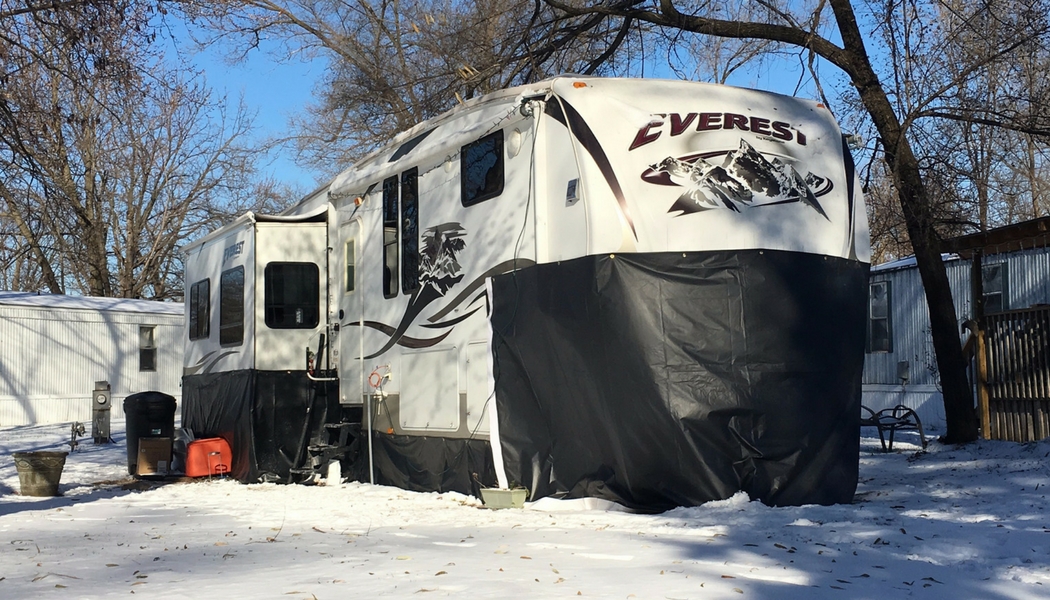











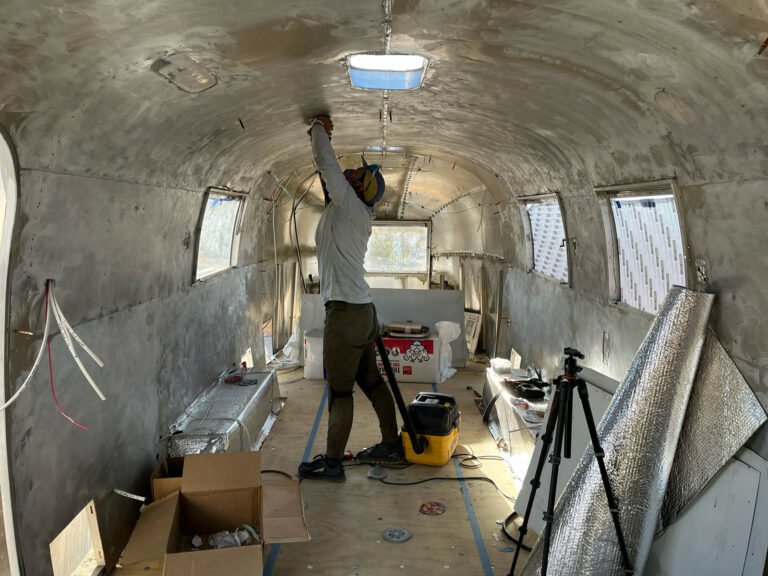
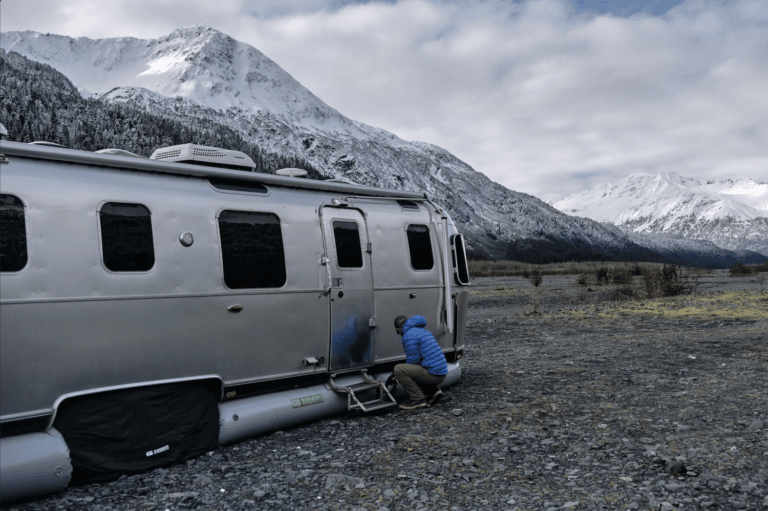
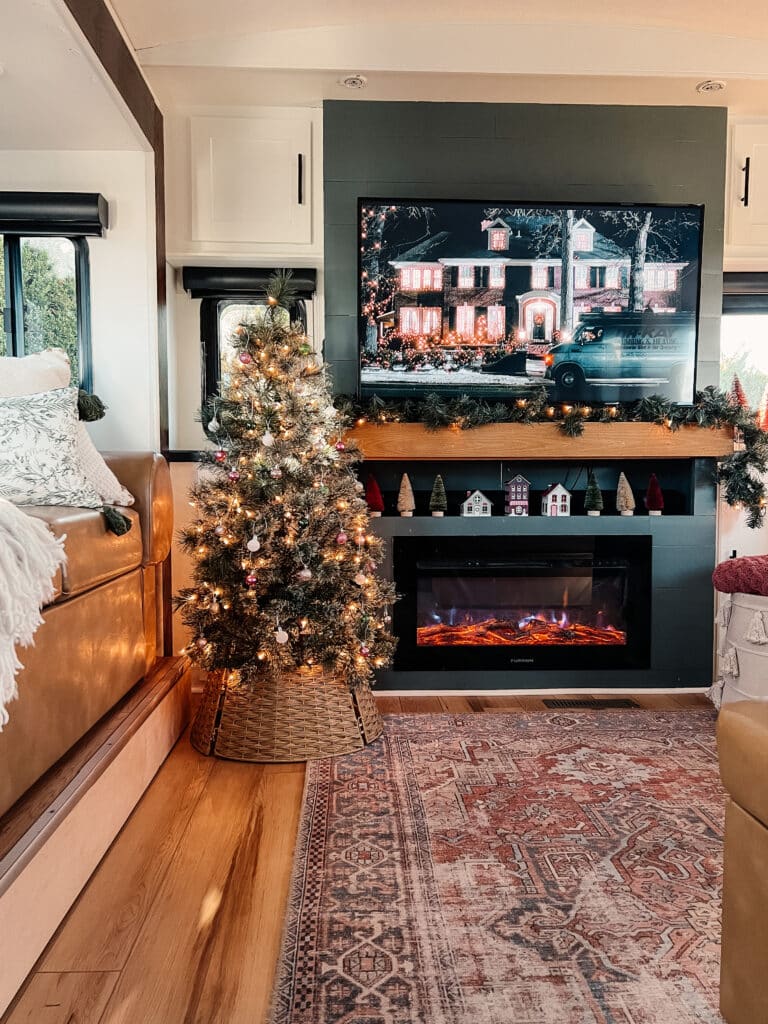

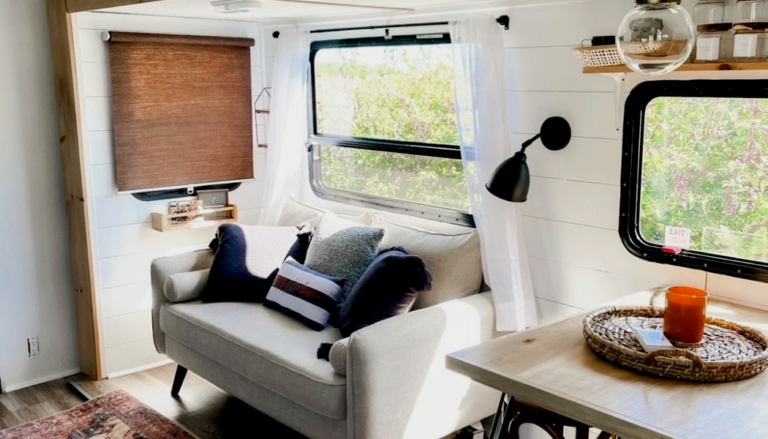
I wonder if the adhesive hooks will set/mount good in cold temps. I was going to back them with the acrylic adhesive tape if not. Just curious
It might depend on how cold – but you could try an idea shared by another commenter who said she runs a hot, damp rag over the RV exterior while warming adhesive items inside her coat to warm the surface and the glue before sticking them. I would definitely use the hooks alone if you’re needing strength; I’d only try acrylic tape if you’re wanting them to be more easily removable, especially since I haven’t tested the acrylic tape for holding skirting and can’t promise that it will hold.
Have you though of using Awning C Rail. It’s a permanent attachment and will not leave gaps. Then put a rope in the hem of your skirting material to slide through the rail.
I hadn’t thought of that before, but that’s a great idea. I like the idea of it looking neater and creating a more perfect seal. Thanks for sharing; hopefully it will help someone else who is looking for a different solution for attaching their skirting!
Just getting my fifth wheel to live in full time. I’ll be in Utah and skirting is a must! How would you attach the rope to the hem? Would you glue the rope or sew a hem to slide rope thru, wouldn’t glue come apart in cold weather? Just learning!
BillboardTarps.com (and possibly other companies as well) sells tarp vinyl that has a “pipe sleeve” around the edges, which is sort of like a hem with a couple of inches of space that you could slide a rope through.
CBurns: I think that would be very good and I already looked up where to buy some and bookmarked it, but since I just got done with putting up the hooks I’ll have to wait, and hope, the hooks hold this winter. My only concern and not sure anyone would know if there is an answer; would the c-rail/c-channel come off easily should a person want to sell the RV or if one uses the c-rail/c-channel on a slide out would it come off to move the slide back in? Anyway, what drew me to the hooks was the statement about them coming off easily without much, if any, marks but I still have to hope they hold during a PA cold winter:-). If they don’t I’m definitely trying the c-rail:-).
I really like your idea and i am going to try it myself this year. However i am windering one thing. Where do i get the bilboard vinal that you used for this oroject?
Hi Christi, I ordered it from billboardtarps.com.
Thank you so much!
As first time RVers we are living in ours until our home is finished. With winter coming I was about to bite the bullet and pay big bucks for a skirt.
I ended up making my own (a project my Dad and I did together-bonus) and saving money while reusing materials instead of trashing them.
Thanks again!
That’s so great to hear! Hope you stay warm and cozy this winter!
My problem here in Louisiana is mostly the opposite…keeping the heat out and the cold A/C in. I’m covering the roof of my 5th wheel with Reflectix and Aluminum tape and found that the roof is really not the biggest problem, it’s the windows. Covering the inside of the windows with Reflectix makes the camper very cave-like but the temperature difference is dramatic. I can set my Dometic thermostat to 72 degrees and the temperature in the main cabin goes to 70 or even 69. But the compressor is still running about 1/2 the time which is a huge difference from running ALL the time with 1/2 the cooling result. So obviously there is still some loss going on and I’m wondering if skirting will help or hurt in 100 degree weather. If anyone knows, I’d appreciate hearing your opinion.
I am not sure how much skirting would help in hot weather. I have noticed it’s very cool underneath my own camper, which is still skirted from winter. Last summer we were in Texas in the direct sun, and we ended up just buying an additional free-standing air conditioning unit from Lowe’s. Our two roof AC’s were struggling to keep up before, but with the free-standing AC plus our main ducted AC, even with the bedroom AC off, we had no trouble keeping the RV as cool as we wanted. Of course our electric bills weren’t cheap! Good luck figuring out a solution!